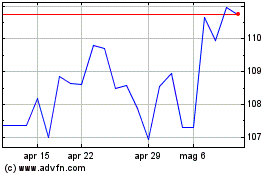Eyewear Makers Rethink Smart Glasses
09 Marzo 2017 - 11:59AM
Dow Jones News
By Manuela Mesco
MILAN -- Several years after the failure of Google's smart
glasses, eyewear makers and tech companies -- encouraged by the
arrival of a giant new player in the eyewear sector -- are taking
another crack at a product they hope can compete in the market for
wearable technology.
The recentEUR50 billion ($53 billion) Italian-French merger
between eyewear manufacturers Luxottica SpA and Essilor
International SA could revive a market that, according to bullish
estimates, could approach 55 million units by 2022. But while
eyewear groups enjoy an edge when it comes to style and
distribution heft, they may struggle to succeed where even the
biggest tech giants have so far stumbled.
The 2012 launch of Google Glass was largely a flop, sunk by
concerns over privacy, competition from other wearable devices and
poor aesthetics that left wearers looking like cyborgs. Today,
Google sells the product mostly for business use and has put aside
the idea of pitching it to a mass audience for now.
After Google, tech companies ranging from startups to the likes
of Microsoft Corp. and Seiko Epson Corp. have all tried new
versions of connected eyewear. But none of them has stood out as a
major commercial success, in many cases because the monitor on the
lenses are too intrusive. Their functions are too similar to
smartphones or the designs too nerdy, analysts say. Privacy
concerns -- such as the problem of using the glasses to take videos
without the subjects' knowledge -- were also a deterrent.
Instead, some tech companies are concentrating on a narrower
audience. U.S.-based Vuzix Corp., a smart-glasses specialist, has
eyewear aimed at business use, such as allowing remote technical
support or training, while Sony Corp. is providing technology for
developers who want to make apps that can be installed in smart
glasses. Snapchat parent company Snap Inc. recently launched
glasses that allow wearers to take photos and videos.
"Phase one...has unquestionably been a flop" in creating a mass
market for smartglasses, said Steven Waltzer, analyst at Strategy
Analytics.
Meanwhile, the eyewear industry -- under pressure to feed
younger customers' desire for new technology -- is instead pressing
to find products that could help carve out a mass market that has
eluded smart glasses so far.
Eyewear maker Safilo SpA turned down an offer in 2014 from
Google to make wired frames because "Google's philosophy was to
bring all the functions of a smartphone into the eyeglasses," said
Nicola Belli, head of innovation at the Italian company. When his
team tested Google's prototypes, "the feeling was of too much
information," he recalled. Google didn't respond to requests for
comment on the project.
Instead, Safilo is now working on its own smart glasses that it
claims can read brain waves and help wearers concentrate, with an
app that guides the person through exercises aimed at regaining
focus. Other eyewear makers are working on overcoming basic
problems such as making the technology smaller, the battery last
longer and the display inside the glasses easier to see in
daylight.
By combining their strengths, the new Essilor-Luxottica group is
aiming high, seeking to put together "our researchers, our frame
designers, all our strengths," Essilor Chairman Hubert Sagnières
said soon after the deal was announced.
Essilor, a major lens manufacturer, is making lenses that
recognize faces and everyday objects. In turn, Luxottica, which
brings expertise in manufacturing frames and had joined with Google
on Google Glass, is working on lighter materials, such as graphite,
that can hold the technology needed for smart glasses without
weighing them down.
The Italian company, which makes stylish glasses for the likes
of Chanel, Giorgio Armani and Prada, can also make a sleeker design
-- thus addressing a major deterrent to the early models of smart
glasses.
"Smart glasses must first be functional, desirable, wearable,"
said Federico Buffa, R&D director for Luxottica. "Then it can
offer useful (smart glasses) functions."
Luxottica already has launched a smart-glasses model under its
sports brand Oakley, with technology from Intel Corp., that it
hopes can compete with other sports wearables.
For instance, the lenses help monitor a wearer's heart rate,
track routes, give feedback on performance and provide customized
training programs. To resolve the issue of images popping out on
the lenses, a voice drives the wearer through the information
needed. Luxottica's enormous distribution heft -- it owns Sunglass
Hut and LensCrafters -- could also help bring smart glasses into
the mainstream, analysts said.
Write to Manuela Mesco at manuela.mesco@wsj.com
(END) Dow Jones Newswires
March 09, 2017 05:44 ET (10:44 GMT)
Copyright (c) 2017 Dow Jones & Company, Inc.
Grafico Azioni Essilor Luxottica (PK) (USOTC:ESLOY)
Storico
Da Giu 2024 a Lug 2024

Grafico Azioni Essilor Luxottica (PK) (USOTC:ESLOY)
Storico
Da Lug 2023 a Lug 2024
